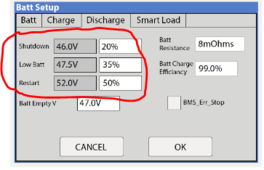Mr.Hyde
New Member
I looked for this answer and was surprised I couldn't find it.
I have a Sol-Ark 15k between my meter and main panel. I have 28kWh of batteries connected to it.
I haven't yet switched to TOU billing, so I just have it configured to try and zero out grid use, and charge the batteries with any leftover PV.
I have it configured to discharge the batteries down to 35%.

In the event of a grid failure, I'd like to continue discharging the batteries down to 5%, but I'm not sure how to automate that.
I also have Solar Assistant hooked up (I was skeptical of closed-source, but it works great!) and so I was looking at the automations there.
I see in the automations, it has a parameter called "Stop battery discharge capacity".

Is this the right parameter to change to 5%?
Should I add a condition so that it doesn't repeatedly set it to 5% if it already is?
I assume I also have to create an automation to restore the value to 35% if the grid comes back?
Again, should I add a condition so that it doesn't keep trying to set it to 35% during nominal operation?
I have a Sol-Ark 15k between my meter and main panel. I have 28kWh of batteries connected to it.
I haven't yet switched to TOU billing, so I just have it configured to try and zero out grid use, and charge the batteries with any leftover PV.
I have it configured to discharge the batteries down to 35%.

In the event of a grid failure, I'd like to continue discharging the batteries down to 5%, but I'm not sure how to automate that.
I also have Solar Assistant hooked up (I was skeptical of closed-source, but it works great!) and so I was looking at the automations there.
I see in the automations, it has a parameter called "Stop battery discharge capacity".

Is this the right parameter to change to 5%?
Should I add a condition so that it doesn't repeatedly set it to 5% if it already is?
I assume I also have to create an automation to restore the value to 35% if the grid comes back?
Again, should I add a condition so that it doesn't keep trying to set it to 35% during nominal operation?



